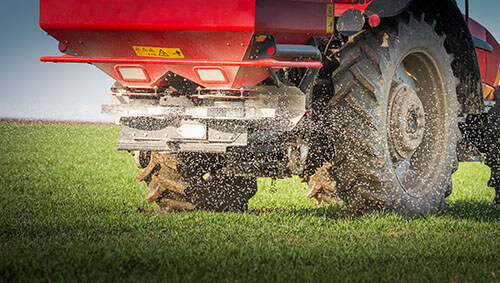Lime: An Important Part of a Fertility Program
Sep 14, 2020

All crops, including corn, soybeans, forages and many others, require nutrients from the soil to grow. The availability of those nutrients to the plants from the soil is greatly dependent on the soil pH, the measure of the acidity or alkalinity of the soil. A soil test is the best way to determine the soil’s pH.
Soil nutrients such as nitrogen, phosphorus, potash, and other minor elements like sulfur, zinc, and boron require a fairly neutral pH ranging from 6.5 to 7.0 to be properly utilized by the plant.
Changes in soil pH can be caused by many factors. Among them are excessive rainfall, uptake by plants of soil calcium, adding soil nutrients like nitrogen, organic matter decomposition, and microbial activity in the soil. Therefore, the soil pH is constantly changing and needs to be watched closely.
If your soil pH is below the optimum range, you can easily adjust it with lime.
Lime is a combination of calcium and magnesium carbonates. Through a complicated process involving hydrogen ions and calcium ions the soil’s pH is raised when lime is added. It can come in many forms and quality levels. The relative effectiveness of lime depends on the fineness (particle size), which will influence the reaction rate with the soil. Most lime will contain both fine and coarse materials. Many states, including Tennessee have laws defining what quality lime can be sold. When making a lime purchase, make sure the seller is providing you with a tag; defining whether or not it meets state standards otherwise it may not make the anticipated changes in your soil.
Making changes to soil pH is a slow process taking 3 to 6 months. The better quality of lime used the quicker and more effective this change becomes. The lower your pH number is below neutral (7) the longer this change takes to happen. For example, a soil pH of 4 is much harder, takes longer and requires more lime to change back toward neutral (7) than a pH of 6. Therefore, plan on checking soil pH on a consistent basis of at least every one to two years.
While nitrogen, phosphorus and potash play a key role in growing a good crop, soil pH and lime are an important part of a full fertility program. Contact your local Co-op Agronomist for more information.
Soil nutrients such as nitrogen, phosphorus, potash, and other minor elements like sulfur, zinc, and boron require a fairly neutral pH ranging from 6.5 to 7.0 to be properly utilized by the plant.
Changes in soil pH can be caused by many factors. Among them are excessive rainfall, uptake by plants of soil calcium, adding soil nutrients like nitrogen, organic matter decomposition, and microbial activity in the soil. Therefore, the soil pH is constantly changing and needs to be watched closely.
If your soil pH is below the optimum range, you can easily adjust it with lime.
Lime is a combination of calcium and magnesium carbonates. Through a complicated process involving hydrogen ions and calcium ions the soil’s pH is raised when lime is added. It can come in many forms and quality levels. The relative effectiveness of lime depends on the fineness (particle size), which will influence the reaction rate with the soil. Most lime will contain both fine and coarse materials. Many states, including Tennessee have laws defining what quality lime can be sold. When making a lime purchase, make sure the seller is providing you with a tag; defining whether or not it meets state standards otherwise it may not make the anticipated changes in your soil.
Making changes to soil pH is a slow process taking 3 to 6 months. The better quality of lime used the quicker and more effective this change becomes. The lower your pH number is below neutral (7) the longer this change takes to happen. For example, a soil pH of 4 is much harder, takes longer and requires more lime to change back toward neutral (7) than a pH of 6. Therefore, plan on checking soil pH on a consistent basis of at least every one to two years.
While nitrogen, phosphorus and potash play a key role in growing a good crop, soil pH and lime are an important part of a full fertility program. Contact your local Co-op Agronomist for more information.